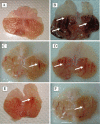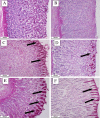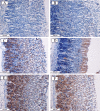Gastroprotective effect of desmosdumotin C isolated from Mitrella kentii against ethanol-induced gastric mucosal hemorrhage in rats: possible involvement of glutathione, heat-shock protein-70, sulfhydryl compounds, nitric oxide, and anti-Helicobacter pylori activity
- PMID: 23866830
- PMCID: PMC3765280
- DOI: 10.1186/1472-6882-13-183
Gastroprotective effect of desmosdumotin C isolated from Mitrella kentii against ethanol-induced gastric mucosal hemorrhage in rats: possible involvement of glutathione, heat-shock protein-70, sulfhydryl compounds, nitric oxide, and anti-Helicobacter pylori activity
Retraction in
-
Retraction Note: Gastroprotective effect of desmosdumotin C isolated from Mitrella kentii against ethanol-induced gastric mucosal hemorrhage in rats: possible involvement of glutathione, heat-shock protein-70, sulfhydryl compounds, nitric oxide, and anti-Helicobacter pylori activity.BMC Complement Med Ther. 2024 Apr 19;24(1):166. doi: 10.1186/s12906-024-04475-5. BMC Complement Med Ther. 2024. PMID: 38641576 Free PMC article. No abstract available.
Abstract
Background: Mitrella kentii (M. kentii) (Bl.) Miq, is a tree-climbing liana that belongs to the family Annonaceae. The plant is rich with isoquinoline alkaloids, terpenylated dihydrochalcones and benzoic acids and has been reported to possess anti-inflammatory activity. The purpose of this study is to assess the gastroprotective effects of desmosdumotin C (DES), a new isolated bioactive compound from M. kentii, on gastric ulcer models in rats.
Methods: DES was isolated from the bark of M. kentii. Experimental rats were orally pretreated with 5, 10 and 20 mg/kg of the isolated compound and were subsequently subjected to absolute ethanol-induced acute gastric ulcer. Gross evaluation, mucus content, gastric acidity and histological gastric lesions were assessed in vivo. The effects of DES on the anti-oxidant system, non-protein sulfhydryl (NP-SH) content, nitric oxide (NO)level, cyclooxygenase-2 (COX-2) enzyme activity, bcl-2-associated X (Bax) protein expression and Helicabacter pylori (H pylori) were also investigated.
Results: DES pre-treatment at the administered doses significantly attenuated ethanol-induced gastric ulcer; this was observed by decreased gastric ulcer area, reduced or absence of edema and leucocytes infiltration compared to the ulcer control group. It was found that DES maintained glutathione (GSH) level, decreased malondialdehyde (MDA) level, increased NP-SH content and NO level and inhibited COX-2 activity. The compound up regulated heat shock protein-70 (HSP-70) and down regulated Bax protein expression in the ulcerated tissue. DES showed interesting anti-H pylori effects. The efficacy of DES was accomplished safely without any signs of toxicity.
Conclusions: The current study reveals that DES demonstrated gastroprotective effects which could be attributed to its antioxidant effect, activation of HSP-70 protein, intervention with COX-2 inflammatory pathway and potent anti H pylori effect.
Figures









References
-
- Anand S, Nagaraju B, Ahmed N, Swain SR, Ahmed F, Padmavathi G, Narendra Sharath Chandra J, Shampalatha S. Antiulcer activity of Trigonella foenum-graecum leaves in cold restraint stress-induced ulcer model. Mol Clin Pharmacol. 2012;3(1):90–99.
-
- Ramakrishnan K, Salinas RC. Peptic ulcer disease. Am Fam Physician. 2007;76(7):1005–1012. - PubMed
-
- Taha MME, Salga MS, Ali HM, Abdulla MA, Abdelwahab SI, Hadi AHA. Gastroprotective activities of < i > Turnera diffusa</i > Willd. ex Schult. revisited: Role of arbutin. J Ethnopharmacol 2012. Taha MME, Salga MS, Ali HM, Abdulla MA, Abdelwahab SI, Hadi AHA: Gastroprotective activities of < i > Turnera diffusa</i > Willd. ex Schult. revisited: Role of arbutin. J Ethnopharmacol. 2012;141(1):273–281. doi: 10.1016/j.jep.2012.02.030. - DOI - PubMed
Publication types
MeSH terms
Substances
LinkOut - more resources
Full Text Sources
Other Literature Sources
Medical
Research Materials
Miscellaneous

